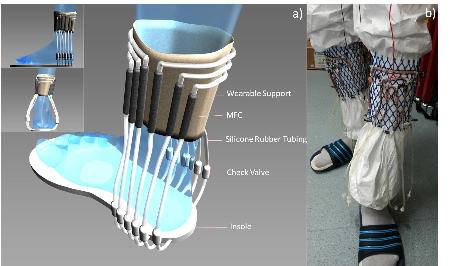Researchers create a pair of socks that generates energy from urine
Imagine if you owned a pair of socks that allowed every step you took to power a wireless transmitter to send a signal to a PC. Now imagine it was running on urine.
While it seems far-fetched, researchers from the Bristol BioEnergy Center at the University of the West of England have created such a system — the first self-sufficient system powered by a wearable energy generator based on microbial fuel cell technology.

The pair of socks are embedded with miniaturized microbial fuel cells (MFCs) and fueled with urine pumped by the wearer’s footsteps to create energy. Microbial fuel cells (MFCs) use bacteria to generate electricity from waste fluids by harnessing the biochemical energy used for microbial growth and converting it directly into electricity.
For the experiment, the team, led by Professor Ioannis Ieropoulos, of the Bristol BioEnergy Centre, embedded soft MFCs within a pair of socks, which was supplied with urine that could circulate from the human operator that was walking.
Normally, continuous-flow MFCs would rely on a mains powered pump to circulate the urine over the microbial fuel cells, but this experiment relied solely on human activity. The action of walking caused the urine to pass over the MFCs and generate energy. Soft tubes were placed under the heels, to ensure frequent fluid push–pull by walking.
The tests showed that the wearable MFC system was able to run a wireless transmission board, which sent a message every two minutes to the PC-controlled receiver module.
“Having already powered a mobile phone with MFCs using urine as fuel, we wanted to see if we could replicate this success in wearable technology. We also wanted the system to be entirely self-sufficient, running only on human power – using urine as fuel and the action of the foot as the pump,” said Ieropoulos.
According to Ieropoulos, the team’s successful system opens the door to using waste to power portable and wearable electronics.
“For example, recent research shows it should be possible to develop a system based on wearable MFC technology to transmit a person’s coordinates in an emergency situation. At the same time this would indicate proof of life since the device will only work if the operator’s urine fuels the MFCs,” said Ieropoulos.
This isn’t the only waste-powered work the BioEnergy Center is has taken part in (aside from its pee-powered phone research). Recently it launched a prototype urinal in partnership with Oxfam that uses pee-power technology to light cubicles in refugee camps.

Comments are closed, but trackbacks and pingbacks are open.